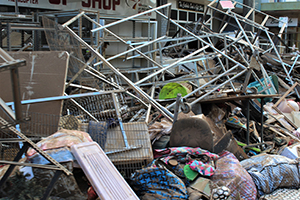Lismore City Council launches a discussion paper and consultation process to consider the future of the devastated city and nearby vulnerable locations. Robin Osborne reports…
Coinciding with President Joe Biden’s ‘Build Back Better’ strategy, a response to the chaos caused by Donald Trump, Lismore City Council has launched a Building Back Better process to address the devastation of the February-March flooding and to plan for the local government area at large – although not necessarily the floodplain – to survive and even thrive into the future.
Acknowledging that the floods ‘necessitate a complete rethink about how we plan to rebuild a regional city located at the convergence of two rivers’, the land management discussion paper invites public submissions before 10 June 2022, and will incorporate input from public forums on 23 and 25 May at Lismore Heights Sports Club.
‘The aim of this review is to agree on a strategic direction for growth and rebuilding in Lismore and to ensure that in the long-term there is a suitable supply of land available for new and existing businesses and a suitable supply of flood-free residential land,’ the Council advises.
Some of the strategic objectives identified for consideration include:
● A planned retreat of the most high flood risk areas of North and South Lismore. Council will advocate for a State and Federal Government funded land swap arrangement to allow residents to move to higher ground but remain close to existing social networks and jobs.
● Protection of the CBD and land on the eastern side of the Wilsons River through flood mitigation measures.
● Investigations into expanding the industrial precinct at Goonellabah.
● Preliminary design and feasibility work to establish whether a new commercial or mixed-use precinct could be located on the golf course land at East Lismore.
● New medium density zoning and increased height controls for strategically located flood-free sites.
The first option, entailing an exodus out of the vulnerable and largely destroyed suburbs on the floodplain, would see hundreds (at least) if not thousands (more likely) of residents and businesses moving to higher ground or leaving the city altogether. It is anyone’s guess what would be left in their wake, and what future for the CBD?
Following feedback from the community, a report with final recommendations will be considered by Council and put out for further comment. Once adopted by Council, maps identifying future growth areas and any related recommendations will be added as an addendum to the Imagine Lismore 2040 LSPS.
LSPSs, or Local Strategic Planning Statements, are a NSW Government requirement for councils to set out the 20-year vision for land-use in their local area, along with the special character and values that are to be preserved and how change will be managed into the future.
Given the massive impacts of flooding on Lismore, and the presumed likelihood that the future may hold more such catastrophic events, ‘managing change’ should be a major focus of the Council’s deliberations, while imagining the town next year, let alone in 18 years’ time, seems a massive task for the planners.
In the words of a classic understatement by Council, ‘Lismore is facing some big decisions about rebuilding and future growth.’
Presumably the answers will lie somewhere between staying and going, but the devil will lie in the detail and the stakes are nothing less than monumental.
















